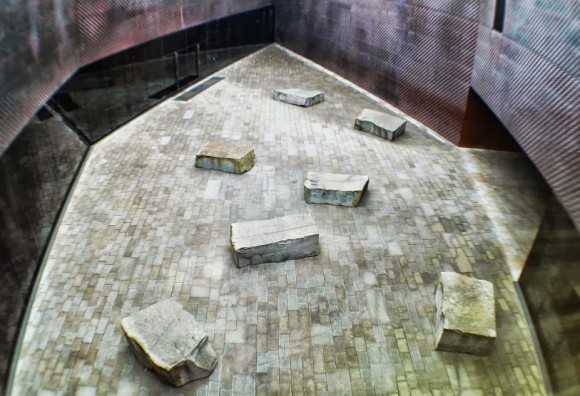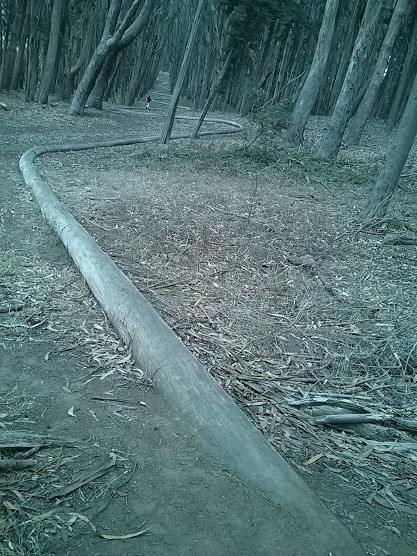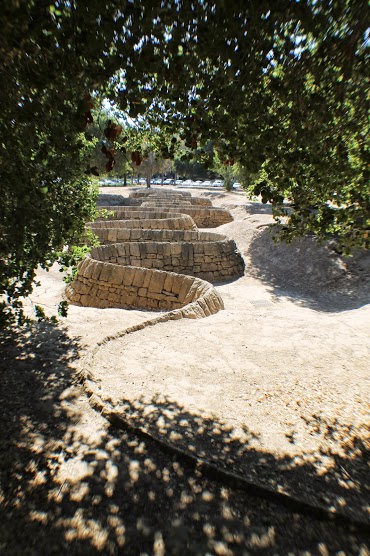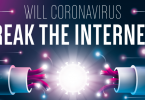aNewDomain.net — Art and science. They do complement each other. Right brain and left brain. Creative destruction and different perspectives on viewing the world. Mercilessly analytical logical constructs for pattern recognition. Root cause failure analysis. Opposites? Or related ways of thinking to do problem solving?
Along that line of thinking I am starting a new series called “Art of the Bay” which looks at art that is displayed in and around the San Francisco Bay Area. To start out I decided to take a look at all the Andy Goldsworthy sculptures in the Bay area and share what I discovered.

“Stone River” detail. Image credit: Richard Hay
Andy Goldsworthy is a sculptor. He works with natural materials including stones, wood, leaves to make ephemeral and permanent works of art. Contrast that with someone like Claes Oldenburg who is famous for taking ordinary objects and making massive sculptures out of them. Binoculars. Safety pins. Erasers. A badminton. Bow and arrow. That is Oldenburg’s thing. He has some pieces in the Bay Area and could be the subject of another chapter in this vein. Another sculptor of note is Alexander Calder (also the inventor of the mobile). He called his sculptures “Stabiles” in contrast to his “Mobiles.”
So what is Andy Goldsworthy’s thing?
Rivers and Tides is a 2003 documentary where he describes his creative process of using natural materials to compose land art in urban and natural settings. It is an example of an artist giving a walk along tour of the creative process. Popular Google+ photographer Trey Ratcliff endorsed this film as a top-notch introspective into left brain thinking and the nature of creativity itself. Watch it.
Andy Goldsworthy is in San Francisco this month working on a new commission for the Presidio Trust called “Tree Fall” in the confined space of the old powder magazine building.
One nice thing about Goldsworthy is that he is still alive and creating new works of art. Calder does not have that going for him.
In total there are four sculptures by Goldsworthy in the Bay Area.
The first one I want to talk about is called “Drawn Stone.” It is on display in the entryway for the de Young Museum in Golden Gate Park.

“Drawn Stone” 2005. Image credit: Richard Hay
He was inspired by the unique character of California’s tectonic topography. So he created cracks in the paver stones and extended this into the cracked-heavy stones set atop the pavers.
I ran into a couple by the “Spire” sculpture later at the Presidio who were familiar with the cracked stone scuplture at the de Young, but did not know it was done by Goldsworthy. They told a story of a family friend who had a crack in the driveway at a time when a daughter’s wedding was coming up. The friend expressed a desire to fix the crack so it would not appear in wedding photos of the bride leaving the house heading for the church. They countered that the museum had paid a great deal of money to make cracks on purpose. Clearly they picked up on the California tectonic crack theme right away.
Nearby in the Presidio is a sculpture called “Spire.” that reminds me of a bonfire. Specifically for me it invokes memories of the “Aggie Bonfire” at Texas A&M, which I helped build and conflagrate from 1989 – 1993.

“Spire” 2008. Image credit: Richard Hay
A more relevant local example related to this is Burning Man. The first Burning Man was held at Baker Beach in San Francisco in 1986 (hence the local reference).
The city’s park service said nix to a second Burning Man feast at the beach, so the festival relocated to the Blackrock desert. This year’s Burning Man get-together begins on Monday, Aug. 26, and ends on Monday, Sept. 2. More information can be found here.
The other Goldsworthy sculpture on display at the Presidio is “Wood Line.” In this piece he took advantage of a large gap in the eucalyptus grove where cypress trees had been planted and fallen. He made a weaving line of trees that, according to the Presidio Trust website, “draws the place.”

“Wood Line” 2010. Image credit: Richard Hay
While I was there a woman walked up and down the wood line for exercise. Love it.
Finally there is the piece Andy Goldsworthy did for Stanford University’s Cantor Art Center 12 years ago in August of 2001. He brought eight wallers from Scotland with him, and they worked six days a week, 11 hour days for three and half weeks to make “Stone River.”
It weighs about 128 tons and it is 320 feet long. It has about 7,500 stones in it includes 700 “triangle” cap stones cut to fit the top of the serpentine sculpture.

“Stone River” 2001. Image credit: Richard Hay
It was made from stone rubble of buildings that collapsed in the 1906 and 1989 earthquakes in the Bay Area. So it has that tie to the California tectonic topography as well. Perhaps my favorite feature is that it is about 5 feet tall and it is a 6 foot ditch so you can be 5o feet away from it and not see it. I have spoken to many people who have frequently visited the Cantor Art Center and had no idea it was there.
So that covers the four finished pieces on display in the Bay Area. If Andy Goldsworthy happens to read this, perhaps he would be interested in coming over and giving a talk at the Google campus. I am sure I can find the requisite 14 Googlers to express interest required to create such a talk. Google is often accused of having a right brain bias, so how better to improve the left brain than to come over and communicate a left brain exercise or two (or five).
Here’s a really wild idea: what if someone decided to sponsor a Goldsworthy sculpture at the Googleplex? Perhaps a stone homage to the Google onebox (the magic box under the Google logo on the home page). Surely the iconic UI is worthy of such an homage. At least pitch him on the idea before Apple grabs him and commissions a stone circle or infinity symbol.
Assuming he would be the least bit interested in either idea of course. Which is wild random speculation on my part. And, of course, I am totally kidding.
I enjoy his work and I hope you have, too.
I am Richard Hay at aNewDomain.net. I am a staff engineer in network testing at Google. Contact on aNewDomain.net. Richard@aNewDomain.net and +Richard Hay on Google+.














Are you sure your totally kidding? Cause I know you.. I think not.. ; )
~Melanie